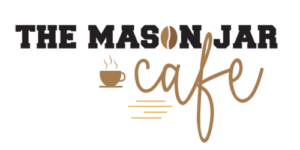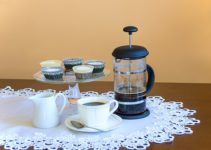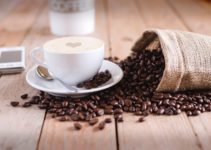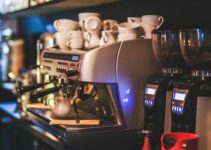
How much caffeine in a shot of espresso?
Do you need a jolt of caffeine to start your day? A shot of espresso can give you the boost you need to get going. But how much caffeine is in a shot of espresso? And what are the other benefits of drinking espresso?
In order to make informed decisions about our caffeine intake, it’s important to understand how much caffeine is in various types of coffee. A shot of espresso, for example, contains significantly more caffeine than a cup of regular brewed coffee. So if you’re looking for a quick burst of energy, an espresso may be the better choice for you. Keep in mind, though, that the high concentration of caffeine can also lead to some unwanted side effects if consumed in excess. With that in mind, be sure to enjoy your espresso responsibly!
How much caffeine in a shot of espresso? In this blog post, we will answer all your questions about caffeine and espresso. Let’s get started!
Table of Contents
Espresso
Espresso is the most common form of coffee in Italy and also the base for many coffees around the world. The term “espresso” refers to a method, not an actual beverage. The word itself comes from the Italian verb “stirare” meaning ‘to stir.’ Espresso preparation involves forcing hot water under pressure through finely ground and compacted coffee: the resulting liquid is thick and syrupy with a layer of crema on top. Since espresso beans are roasted differently than other types of coffee, they produce a stronger flavor that carries more caffeine. Espresso drinks can be made using hot or cold water as well as steamed milk foamed by steam, sometimes called caffe latte or cappuccino.
The word “espresso” came into use by the Knights of the Kilted Bean (founded in 1906) and later became a trademark. The term “cappuccino” is not directly connected with the Italian name for the Capuchin friars, which was shortened to “cappuccini”, but comes from Latin ‘caputium’ meaning ‘hood’ referring to the hooded robes worn by monks. So cappuccino means ‘little monk’ or an allusion to monks who wear brown robes with white trim. Today, many coffee houses continue this tradition — some having large espresso machines behind their counter topped with wooden steamed milk pitchers, some still wearing brown habits portraying baristas humble servants of the people.
Nowadays, the term espresso has come to refer to all coffee drinks prepared with pressurized water. The French have a similar drink named cafe au lait which is made by adding hot milk or cream to strong coffee. A related beverage in some parts of Europe is a cappuccino, a shot of espresso with foamed hot milk on top. In northern Italy where the Italian macchiato is popular, it’s customary to put just a dollop of steamed, frothed milk on top of an espresso instead of half and half foam. In southern Italy, particularly Naples, caffe freddo or cold coffee is popular which can be sweetened instantly before serving (known as “akerato”).
Espresso beverages combine the advantages of both coffee and espresso. Espresso is strong, concentrated, and has a very distinct taste which can be varied in many ways for flavor or enhanced by adding chocolate, whipped cream, etc. Coffee brewed with hot water does not have the same intensity of flavor that espresso has; but coffee is much simpler to make than espresso drinks. One advantage that comes from its strength is that it’s good to drink black (with no sugar) because you won’t need nearly as much to get the same caffeine kick. After drinking your morning cup of joe you might find yourself craving another 20 minutes later — but after 2 shots of espresso most people feel pretty satisfied until lunchtime.
The most popular way to serve espresso is by combining it with varying amounts of hot water to make a drink called “ristretto” (restricted) which is more concentrated than regular espresso. Ristrettos are also known as short blacks or Americanos in some places. A normal serving of espresso might contain about 1 ounce while ristrettos have only .6 ounces or so. A double shot of espresso, usually taken by experienced drinkers, contains about 2 shots worth or about 3 ounces total. Those who like the intense flavor but not the high caffeine content often order lungos which is made up of around 6 parts water to 1 part espresso for a total of 6-7 fluid ounces.
Espresso has grown in popularity in since 1960’s when automobile manufacturers began including espresso machines in their cars. Starbuck’s, Peet’s Coffee & Tea, Seattle’s Best Coffee and other coffee shops now serve up a wide variety of espresso drinks along with tea, iced drinks, biscotti cookies and other goodies. You can now find espresso served with cream at nearly every diner across the nation making it even more popular than traditional drip brewed coffee.
The phrase “espresso coffee” is trademarked by the World Barista Championship to prohibit its use for inferior beverages or those made with substandard equipment which does not meet their standards for delivering authentic espresso. So if you order an “espresso”, make sure you know what you’re getting!
The Pros And Cons Of Espresso
For many of us, espresso is a daily ritual. We get up, look forward to that first sip and enjoy the flavor while also taking comfort in the warmth of our cups. But did you know there are some drawbacks to your morning cup o’ joe? What follows are the pros and cons of drinking espresso every day.
The Pros Of Drinking Espresso Every Day
– It’s A Healthy Addiction
Short of having a drug addiction, espresso can be looked at as being one of the healthiest addictions out there. How many other things do you look forward to each day? Many people say they can’t wait for their first cup of coffee (espresso) every morning – it gives them energy and gets them moving in the right direction. Now that’s something worth waking up to!
– Easy To Make At Home Or The Office
You don’t need to be an expert barista or own your own espresso machine – all you need is hot water and you only need two ingredients (one for strong coffee, three if you like it weaker) and it’s ready to go. Even better, for those of us who don’t have the time or budget to go out and buy themselves an espresso machine, you can easily make your own at home with a French press or in the office with a coffee maker that uses pods.
– Social Drink
Whether your vice is cappuccino, latte, mocha, macchiato…the list goes on and on – one thing we can all agree on is how great it feels when we share our favorite drinks with friends. And since sharing is caring (or drinking in this case), there’s nothing wrong with going out for coffee every once-in-a-while to catch up with friends or trying new flavors you haven’t tried.
– Traveling Made Easy
If you’re one of those people who can’t go through the day without your espresso fix, having an espresso machine is just what you need to help simplify things. Yes, I know even if it’s only a short distance away to the nearest coffee shop, no one wants to take time out of their busy schedule for a cup of caffeine. That’s why owning your own machine definitely makes life easier and more convenient no matter where you are or where you’re going. You’ll never have to worry about running out of supplies again!
– The Positive Effects Of Caffeine Last Longer Than Alcohol
Need I say more? Well…since I already used up my word count, I suppose I should. Sure caffeine is known to give us energy and make us feel more focused since it stimulates the central nervous system, but did you know that’s not where the positive effects end? The truth is caffeine has been shown to have long-term benefits of lowering risk for some cancers – another reason it’s perfectly fine to get.
The Cons Of Drinking Espresso Every Day
– Coffee Spills On Your Clothes
Can’t tell you how many times I’ve knocked over my coffee mug on my way out the door to work – spilling not only the drink but my morning wake-up juice on myself in the process. Any spills while sipping from an espresso cup can be particularly difficult to clean-up because it has more surface area thanks to the tiny little cup.
– Espresso Stains Your Teeth
If you’re one of those people who can’t wait until you get to your desk before taking that first sip, be careful! Rinse with water immediately after to help prevent stains. Also don’t forget it’s a good idea to carry dental floss with your morning latte because espresso is notorious for getting stuck between teeth.
– Nightmares From The Caffeine
We all know caffeine has the ability to keep us awake – not something everyone wants in their right mind. If you’re one of those people who gets nightmares after drinking coffee at night, try switching over to decaf or tea for an evening pick-me-up instead.
– Expensive Habit
If you’re a daily espresso drinker, odds are you could buy yourself something nice with the money you’ve saved. Many people don’t even make it out of the house without their morning fix – that’s how strongly they feel about their brand of choice. Of course it’s personal preference, but if there’s one thing many people can agree on it’s that the price to buy an espresso machine is nothing compared to what having your caffeine in disposable cups adds up to over time.
– Stomach Aches
How much caffeine in a shot of espresso? If you have problems digesting milk or are lactose intolerant, try switching over to soy milk for all your beverages including espresso because many find this helps reduce stomach aches caused by drinking espresso.
What is Caffeine?
Caffeine is a well-known stimulant, and the world’s most popular psychoactive drug. Caffeine can be found in such unlikely sources as chocolate, kola nuts, and the yerba mate plant. Coffee provides nearly one-third of all caffeine consumed by Americans.
Caffeine is an effective ergogenic aid (a substance that enhances muscular work capacity). It stimulates the central nervous system (CNS) to release free fatty acids from body stores and decrease feelings of fatigue during physical exertion. This may allow you to train harder and longer with less rest time between sets and exercises — ultimately, leading to increased strength and performance.
The best way to get caffeine into your system is through coffee or other caffeine-containing beverages. Other sources are no substitute for these beverages because their caffeine content is diluted by the ingredients of the source. Keep in mind that caffeine’s direct effect on fat cells can last up to 12 hours post-ingestion, making coffee a good choice before training.
Caffeine stimulates the CNS by inhibiting adenosine receptors, leading to increased activation of dopamine receptors and norepinephrine receptors. Caffeine also inhibits phosphodiesterase (PDE), an enzyme responsible for breaking down cAMP — otherwise known as cyclic adenosine monophosphate, or cyclic amp. The latter compound is critical to muscle contraction because it helps release calcium from the sarcoplasmic reticulum within muscle cells. More calcium leads to increased force of contraction and greater endurance — both of which can help you lift more weight for more reps than usual during training.
Caffeine also enhances post-training glycogen synthesis, meaning that the body is better able to replenish its supply of glycogen following exercise. Glycogen is important to performance because it’s responsible for fueling anaerobic movement through glycolysis (breakdown of glucose into ATP). Studies have shown that caffeine ingestion before resistance training improves both peak power production and total work performed during a workout session. The former measures are very important in sports where short bursts of high-intensity activity are required, such as sprinting or throwing events in track and field, or hitting in baseball.
The Advantages And Disadvantages Of Caffeine
Caffeine is the most widely used drug in the world. Found in coffee, tea, chocolate and many other products, it has become an essential part of everyday life. But caffeine also has a darker side that few users are aware of. It can have numerous negative side effects on your well-being when consumed regularly in large doses. Here are some of the pros and cons of caffeine use.
The Advantages
– Caffeine is an antidepressant
Drug companies have been looking for years for the perfect anti-depressant that isn’t addictive and doesn’t have any side effects. They haven’t found one yet, but they might have stumbled across it in the form of caffeine instead. A recent study showed that rats given caffeine displayed fewer symptoms of depression.
– Caffeine speeds up your metabolism
Caffeine increases the amount of epinephrine and norepinephrine in your body, which boosts your metabolism. This effect has been shown to last for several hours after you consume it, so even though you may have a cup of coffee at 8 a.m., you’ll still be burning calories at noon.
– Caffeine keeps you alert and awake
If there’s one thing we could all use, it’s more hours in the day. From an evolutionary perspective, however, we seem to have evolved to function on less sleep than is now considered healthy. At least that’s the reasoning scientists have come up with for why humans seem to need coffee in order to get through a normal day. This lets you squeeze more into a day, making it feel just a bit longer.
– Caffeine strengthens your memory and mental performance
If you’re looking for an instant temporary boost in memory and mental performance, caffeine is your drug of choice. People who are tired often have a hard time focusing, and caffeine helps them overcome this temporary condition. In one study, people who were sleep deprived for 24 hours saw their memories increase by up to 20% after ingesting caffeine.
– Caffeine fights Parkinson’s disease and Alzheimer’s disease
A number of studies have found that caffeine can help protect against Parkinson’s disease and Alzheimer’s disease. Caffeine has been shown to reduce the amount of free radicals in your body, which is believed to be one cause of these diseases.
– Caffeine reduces your risk for type II diabetes
There are a number of complications that come with diabetes. If you avoid caffeine, however, your risk of developing type II diabetes can increase by up to 22%.
– Caffeine increases physical performance
It’s a common belief that caffeine dehydrates people and interferes with physical activities like running and biking. In reality, though, it does the opposite for most people. A study found that people who consumed caffeine before exercising saw a 13% increase in performance, and their endurance increased as well.
– Caffeine increases your athletic performance by as much as 15%
A study on running found that those who took caffeine an hour before treadmill running were able to run for nearly twice as long as those who hadn’t consumed caffeine. And it wasn’t because the caffeine was dehydrating them, either.
– Caffeine lowers your risk of developing kidney stones
There are a number of foods and beverages that can increase your risk for getting kidney stones, but there are only a few that have been shown to decrease your chance for developing these painful lumps. One of these is caffeine. A study found that people who consumed two or more caffeinated beverages a day had a 40% lower risk of developing kidney stones than those who didn’t consume caffeine at all.
– Caffeine can reduce your chances for getting Parkinson’s disease, multiple sclerosis and gallstones
How much caffeine in a shot of espresso? Even if you already have one of these conditions, drinking caffeinated drinks can help you manage your symptoms. Caffeine blocks adenosine receptors in your brain and spinal cord, which might reduce the chances of developing Parkinson’s disease. Multiple sclerosis is a nervous system disorder where caffeine has been shown to slow its progression. And research on gallstones shows that 1-3 cups of coffee a day can reduce your risk of developing one of these painful lumps by as much as 50%.
The Disadvantages
– Addictive and Withdrawal Symptoms
Caffeine is a mild stimulant, meaning that it can be both psychologically and physically addictive. Over time the body becomes so used to having caffeine in its system that it can’t function normally without it — this is known as building a tolerance. If you try to quit caffeine after having been addicted for a long time, you can have severe withdrawal symptoms including headaches and irritability.
– Sleep Problems
Caffeine is also a mild diuretic, meaning that it tends to increase your thirst and disrupt your sleep cycles. This manifests most commonly as insomnia or sleeplessness, which can result in fatigue and decreased energy levels the next day. This effect is especially pronounced if you consume caffeine too late in the day or drink more than one caffeinated beverage per day.
– Increased Blood Pressure and Heart Rate
Like other stimulants, caffeine causes an increased heart rate and blood pressure — this is especially true for people who don’t normally consume caffeine. Together, these two effects can increase the risk of a heart attack or stroke.
– Gastrointestinal Problems
Caffeine can cause indigestion, stomach pain and even nausea in high doses. This is especially true if you drink caffeinated beverages on an empty stomach. In some cases the only remedy to these conditions is to simply stop using caffeine for a while.
– Negative Effects on Children and Pregnancy
Caffeine has been shown to decrease fertility in men, so it should be avoided by anyone concerned about having children in the future. Moreover, caffeine intake during pregnancy can lead to miscarriage or low birth weight babies. Breastfeeding mothers should also limit their caffeine intake as it can be passed into breast milk and have negative effects on the child.
– Poor Nutrition
Finally, caffeine limits your body’s absorption of important nutrients such as B12, calcium and iron. This is especially true if you drink caffeinated beverages instead of eating balanced meals throughout the day — like most caffeinated consumers are wont to do.
How Much Caffeine In A Shot Of Espresso?
There are about 75-125mg (3/4 to 1.5 teaspoons) of caffeine in an average shot (1.5 oz.) of espresso, depending on the strength and roast level. This is about half the amount found in drip coffee, but since many people use two shots instead of one, the total caffeine might be similar.
Caffeine is a drug that stimulates the central nervous system and increases heart rate, blood pressure and urine production. Caffeine has been shown to have positive health effects such as improved mood and retention of cognitive function in people with Alzheimer’s disease or dementia.
However, drinking too much caffeinated coffee can lead to a number of negative effects such as an increased risk of diabetes, heart disease, anxiety and depression.
How much caffeine in a shot of espresso? A shot of espresso from many popular Starbucks locations contains around 100mg caffeine. A plain drip cup of coffee from Starbucks has approximately 260-460mg caffeine. In the United States there is currently no legal limit on how much caffeine can be contained in a serving of an energy drink.
How Many Shots Of Espresso Equal A Cup Of Coffee?
This is one question that we frequently get asked and as such, I’ve decided to answer it here and now.
Although there is no perfect answer (depending on what kind of coffee you’re using), I’m going to give an approximate number: A shot of espresso is somewhere in the 1 to 15 fluid ounce range, and a pod espresso machine will pod anywhere from 1 to 13 grams of ground coffee. I would say that on average, a shot of espresso is about 2 ounces, which means one pod contains about 8 grams of ground coffee.
What Causes The Difference In Caffeine Levels With Espresso And Drip?
There are several factors that contribute to the caffeine levels in espresso vs drip coffee. Many people are very interested in knowing about how much caffeine there is in espresso, often comparing it with traditional drip coffee. There are many different variables that can change the caffeine levels between the two – extraction time, the amount of coffee required to make an espresso shot, and even how good you are at pulling that perfect shot.
With drip coffee there is no limit to the amount of extraction you can achieve in one cup. With espresso cups most people generally stop when they start seeing crema which is about 1 ounce (30ml). Some people will let the espresso drip into the cup until it’s 2 ounces (60ml) while others will stop when they see that golden brown color which is about 1.5 ounces (45 ml). It really depends on personal preference, but to get a general idea of what things would look like, check out this picture to see how much crema is pulled from a perfect shot of espresso.
With drip coffee you will typically extract more caffeine since there are no limits to how much water you can extract the ground coffee with. Depending on how fine your ground coffee is, it may take up to 2 tablespoons (10ml) of ground coffee for each 6 ounces (180ml) of water to extract the desirable flavors and caffeine levels you desire.
With drip coffee you can expect to get about 120-200mg of caffeine per 10 ounces (300ml) depending on how finely ground your coffee is and how dark or light you roast it. If you enjoy darker roasts then you do not need as much grounds and vice versa for lighter roasts. Generally a darker roast will mean you need about 1 tablespoon (6ml) of ground coffee for each 6 ounces (180 ml) of water.
How much caffeine in a shot of espresso? So now that you have a general idea of how much caffeine there is in drip coffee vs espresso, here is an infographic to help explain some other factors that can affect it as well as a summary of how to get the most out of your caffeine.
FAQs About How Much Caffeine In A Shot Of Espresso
How Many Milligrams Of Caffeine Are In A Shot Of Espresso?
There is approximately 95-105 milligrams of caffeine in an average 1.5 fluid ounce shot of espresso. A double shot (2 ounces) contains 200-210 milligrams, while a triple (3 ounces) contains 295-305 milligrams. There also exists four shots of espresso(4 oz), containing 405 milligrams or more for those individuals who like it extra strong! For comparison purposes, here are some other caffeine levels according to amount: 6 oz drip coffee 100 6 oz decaffeinated coffee 2 8 oz cola 37 8 oz chocolate milk 20 10 oz latte 75 12 oz brewed tea 24-65 12 oz energy drink 110 12 oz brewed coffee 100-200 12 oz soft drink 45 1 ounce espresso (1 shot) 95 1 ounce espresso (2 shots) 200 1 ounce espresso (3 shots) 300 1 ounce espresso (4 shots) 400 Starbucks(R) Pike Place Brewed Coffee 14.
How Is Caffeine Different In Decaf?
Decaffeinated coffee has almost always less caffeine than regular coffee. The exception to this rule are the brands of coffee that are specifically advertised as containing more caffeine.
What Makes Up The Rest Of A Shot After You Take Out The Caffeine?
A shot’s volume contains many soluble solids, including sugars and minerals that come from the green bean! And for those individuals who have an issue with mineral buildup in their automatic machine, there is a solution: “decaffeinated” coffee.
A Shot Only Contains 1% Caffeine, So Why Do Some People Say They Get Wired After Drinking It?
How much caffeine in a shot of espresso? The average person metabolizes caffeine at the rate of 15-20 milligrams per hour. If you drink that same 5 ounce cup of decaf four times throughout the course of an evening, you would be getting about 80 milligrams of caffeine (and these effects may not be all from the caffeine!).
Since Espresso Is Such A Strong Flavor, Does This Mean It Has More Caffeine Than Regular Drip Or French Press Coffee?
No! The strength and intensity in flavor comes from oils extracted during the roasting process, as well as beans selected for their quality. The oils and the quality of the bean are what make it stronger in taste, not caffeine.
How Does This Factor Into Making Coffee At Home?
If you want to make espresso drinks at home, there is an ok selection of espresso machines on the market (for example – Krups, Gaggia). Many people like to use their automatic drip machine to pull a shot because they can do several shots back-to-back without breaking down the machine. Remember that every time you pull a shot through your automatic drip machine, you are losing about 2 ounces each time due to spilling or overflow!
What Country Consumes The Most Caffeine Per Capita?
How much caffeine in a shot of espresso? The answer for this question would have to be Sweden. As far as the United States, we rank rather low with a measly 10 pounds consumed per capita!
How Much Caffeine Is In Chocolate?
Chocolate can be a very sneaky source of caffeine. For example, if you enjoy hot chocolate made from cocoa powder and milk, this contains about 20 milligrams of caffeine per ounce. If you have ever tasted Hershey’s(R) Special Dark Chocolate bar- it has around 30 milligrams. The same goes for a cup of Nestle(R) Quik – 27 milligrams!
>>> The Espresso Guide For Beginners | How much caffeine in a shot of espresso?
Espresso is a coffee drink made by forcing hot water under pressure through finely ground, highly roasted coffee beans. Traditionally served in an espresso cup or demitasse with the foam topping called crema; it’s one of the most popular beverages worldwide and can be found at nearly any local café. We know that the answer isn’t always easy to come by and we want to help you get all your questions answered! So let’s start with what will probably be one of the most common inquiries- how many milligrams is there?
How much caffeine in a shot of espresso? The caffeine content varies depending on how long you steep your grounds for, but generally ranges from 75-125mg (3/4 to 1.5 teaspoons) of caffeine in an average shot (1.5 oz.). So if you’re looking to get that extra boost before heading into work today, try adding some espresso shots to your morning routine!
Read more:



